Electrospun Polyvinylidene Fluoride Piezoelectric Fiber Glass/Carbon Hybrid Self-Sensing Composites for Structural Health Monitoring
Abstract
1. Introduction
2. Materials and Methods
2.1. Materials
2.2. Preparation of Piezoelectric PVDF Composite Membrane
2.3. Characterization of Piezoelectric PVDF Composite Membrane
2.4. Fabrication of Self-Sensing Composite Laminate
- (1)
- Whether to replace glass fibers and embed a PVDF composite membrane.
- (2)
- Replacing different numbers of glass fibers
- (3)
- Different embedding positions
2.5. Four-Point Bending Test
2.6. Low-Velocity Impact Test
3. Results and Discussion
3.1. Characterization of PVDF Composite Membrane
3.2. Mechanical Test of Self-Sensing Composite Laminate
3.3. Piezoelectric Response of Self-Sensing Composite Laminate
3.3.1. Four-Point Bending Test
3.3.2. Low-Velocity Impact Test
- Linear response: The piezoelectric response in this region is positively linearly correlated with the impact energy; this corresponds to the region of normal applicability.
- Extreme response: The piezoelectric response in this region is nonlinear due to the large impact energy; the response is thus the maximum peak value that the piezoelectric membrane can produce.
- Sensor failure: In this region, due to the excessive impact energy, the composite laminate is severely damaged, and it has no sensing ability.
4. Conclusions
Author Contributions
Funding
Data Availability Statement
Conflicts of Interest
References
- Giurgiutiu, V. SHM of aerospace composites–challenges and opportunities. In Proceedings of the Composites and Advanced Materials Expo, Dallas, CA, USA, 26–29 October 2015; pp. 26–29. [Google Scholar]
- Giurgiutiu, V. Structural health monitoring (SHM) of aerospace composites. In Polymer Composites in the Aerospace Industry; Elsevier: Amsterdam, The Netherlands, 2020; pp. 491–558. [Google Scholar]
- Ahmed, O.; Wang, X.; Tran, M.-V.; Ismadi, M.-Z. Advancements in fiber-reinforced polymer composite materials damage detection methods: Towards achieving energy-efficient SHM systems. Compos. Part B Eng. 2021, 223, 109136. [Google Scholar] [CrossRef]
- Vishwanath, R.; Rohit, B. A Review on Inspection and Maintenance of FRP Structures. In Proceedings of the IOP Conference Series: Materials Science and Engineering, Kazimierz Dolny, Poland, 21–23 November 2019; Volume 520, p. 012003. [Google Scholar]
- Gupta, V.; Sharma, M.; Thakur, N. Optimization Criteria for Optimal Placement of Piezoelectric Sensors and Actuators on a Smart Structure: A Technical Review. J. Intell. Mater. Syst. Struct. 2010, 21, 1227–1243. [Google Scholar] [CrossRef]
- LSwallow, L.M.; Luo, J.K.; Siores, E.; Patel, I.; Dodds, D. A piezoelectric fibre composite based energy harvesting device for potential wearable applications. Smart Mater. Struct. 2008, 17, 025017. [Google Scholar] [CrossRef]
- Tuloup, C.; Harizi, W.; Aboura, Z.; Meyer, Y.; Khellil, K.; Lachat, R. On the use of in-situ piezoelectric sensors for the manufacturing and structural health monitoring of polymer-matrix composites: A literature review. Compos. Struct. 2019, 215, 127–149. [Google Scholar] [CrossRef]
- Ju, M.; Dou, Z.; Li, J.-W.; Qiu, X.; Shen, B.; Zhang, D.; Yao, F.-Z.; Gong, W.; Wang, K. Piezoelectric Materials and Sensors for Structural Health Monitoring: Fundamental Aspects, Current Status, and Future Perspectives. Sensors 2023, 23, 543. [Google Scholar] [CrossRef] [PubMed]
- Wan, X.; Cong, H.; Jiang, G.; Liang, X.; Liu, L.; He, H. A Review on PVDF Nanofibers in Textiles for Flexible Piezoelectric Sensors. ACS Appl. Nano Mater. 2023, 6, 1522–1540. [Google Scholar] [CrossRef]
- Zhang, M.; Liu, C.; Li, B.; Shen, Y.; Wang, H.; Ji, K.; Mao, X.; Wei, L.; Sun, R.; Zhou, F. Electrospun PVDF-based piezoelectric nanofibers: Materials, structures, and applications. Nanoscale Adv. 2023, 5, 1043–1059. [Google Scholar] [CrossRef]
- Mohammadpourfazeli, S.; Arash, S.; Ansari, A.; Yang, S.; Mallick, K.; Bagherzadeh, R. Future prospects and recent developments of polyvinylidene fluoride (PVDF) piezoelectric polymer; fabrication methods, structure, and electro-mechanical properties. RSC Adv. 2023, 13, 370–387. [Google Scholar] [CrossRef]
- Abot, J.L.; Song, Y.; Vatsavaya, M.S.; Medikonda, S.; Kier, Z.; Jayasinghe, C.; Rooy, N.; Shanov, V.N.; Schulz, M.J. Delamination detection with carbon nanotube thread in self-sensing composite materials. Compos. Sci. Technol. 2010, 70, 1113–1119. [Google Scholar] [CrossRef]
- Ren, B.; Cho, H.; Lissenden, C.J. A Guided Wave Sensor Enabling Simultaneous Wavenumber-Frequency Analysis for Both Lamb and Shear-Horizontal Waves. Sensors 2017, 17, 488. [Google Scholar] [CrossRef]
- Salmanpour, M.S.; Khodaei, Z.S.; Aliabadi, M.H. Instantaneous Baseline Damage Localization Using Sensor Mapping. IEEE Sensors J. 2016, 17, 295–301. [Google Scholar] [CrossRef]
- Bois, C.; Herzog, P.; Hochard, C. Monitoring a delamination in a laminated composite beam using in-situ measurements and parametric identification. J. Sound Vib. 2006, 299, 786–805. [Google Scholar] [CrossRef]
- Dziendzikowski, M.; Kurnyta, A.; Dragan, K.; Klysz, S.; Leski, A. In situ Barely Visible Impact Damage detection and localization for composite structures using surface mounted and embedded PZT transducers: A comparative study. Mech. Syst. Signal Process. 2016, 78, 91–106. [Google Scholar] [CrossRef]
- Ghoshal, A.; Chattopadhyay, A.; Schulz, M.J.; Thornburgh, R.; Waldron, K. Experimental Investigation of Damage Detection in Composite Material Structures Using a Laser Vibrometer and Piezoelectric Actuators. J. Intell. Mater. Syst. Struct. 2003, 14, 521–537. [Google Scholar] [CrossRef]
- Chung, D.D.L. A review of multifunctional polymer-matrix structural composites. Compos. Part B Eng. 2019, 160, 644–660. [Google Scholar] [CrossRef]
- Yu, Y.; Zhang, B.; Feng, M.; Qi, G.; Tian, F.; Feng, Q.; Yang, J.; Wang, S. Multifunctional structural lithium ion batteries based on carbon fiber reinforced plastic composites. Compos. Sci. Technol. 2017, 147, 62–70. [Google Scholar] [CrossRef]
- Shirshova, N.; Qian, H.; Shaffer, M.S.; Steinke, J.H.; Greenhalgh, E.S.; Curtis, P.T.; Kucernak, A.; Bismarck, A. Structural Composite Supercapacitors. Composites Part A: Applied Science and Manufacturing; Elsevier: The Netherlands, 2013; Volume 46, pp. 96–107. [Google Scholar]
- Chen, H.-Y.; Wu, C.-Y.; Hsueh, Y.-T.; Huang, H.-H. Electromechanical properties of embedded multifunctional energy storage composite with activated carbon fiber/PVDF gel electrolyte. J. Chin. Inst. Eng. 2021, 44, 252–260. [Google Scholar] [CrossRef]
- Nurprasetio, I.P.; Budiman, B.A.; Afwan, A.A.; Halimah, P.N.; Utami, S.T.; Aziz, M. Nonlinear Piezoresistive Behavior of Plain-Woven Carbon Fiber Reinforced Polymer Composite Subjected to Tensile Loading. Appl. Sci. 2020, 10, 1366. [Google Scholar] [CrossRef]
- O’Donnell, J.; Chalivendra, V. Multi-functional glass/carbon fibers hybrid inter/intra laminated composites. Compos. Part C Open Access 2021, 4, 100121. [Google Scholar] [CrossRef]
- Chen, X.; Cheng, S.; Wang, S.; Wen, K.; Shi, C.; Zhang, J.; Zhao, D.; Han, Y.; Chen, X.; Li, B.; et al. Embedding stretchable, mesh-structured piezoresistive sensor for in-situ damage detection of glass fiber-reinforced composite. Compos. Sci. Technol. 2023, 233, 109926. [Google Scholar] [CrossRef]
- Chen, X.; Cheng, S.; Wen, K.; Wang, C.; Zhang, J.; Zhang, H.; Ma, H.; Wu, L.; Li, T.; Li, B.; et al. In-situ damage self-monitoring of fiber-reinforced composite by integrating self-powered ZnO nanowires decorated carbon fabric. Compos. Part B Eng. 2023, 248, 110368. [Google Scholar] [CrossRef]
- Lotfian, S.; Giraudmaillet, C.; Yoosefinejad, A.; Thakur, V.K.; Nezhad, H.Y. Electrospun Piezoelectric Polymer Nanofiber Layers for Enabling in Situ Measurement in High-Performance Composite Laminates. ACS Omega 2018, 3, 8891–8902. [Google Scholar] [CrossRef] [PubMed]
- Hofmann, P.; Walch, A.; Dinkelmann, A.; Selvarayan, S.K.; Gresser, G.T. Woven piezoelectric sensors as part of the textile reinforcement of fiber reinforced plastics. Compos. Part A: Appl. Sci. Manuf. 2018, 116, 79–86. [Google Scholar] [CrossRef]
- Thostenson, E.T.; Chou, T.-W. Carbon Nanotube Networks: Sensing of Distributed Strain and Damage for Life Prediction and Self Healing. Adv. Mater. 2006, 18, 2837–2841. [Google Scholar] [CrossRef]
- Wang, Y.; Wang, Y.; Wan, B.; Han, B.; Cai, G.; Li, Z. Properties and mechanisms of self-sensing carbon nanofibers/epoxy composites for structural health monitoring. Compos. Struct. 2018, 200, 669–678. [Google Scholar] [CrossRef]
- Wang, X.; Chung, D.D.L. Short-carbon-fiber-reinforced epoxy as a piezoresistive strain sensor. Smart Mater. Struct. 1995, 4, 363–367. [Google Scholar] [CrossRef]
- Lynch, J.P.; Wang, K.-W.; Sohn, H.; Haghiashtiani, G.; Greminger, M.A.; Zhao, P. Poling of PVDF matrix composites for integrated structural load sensing. In Sensors and Smart Structures Technologies for Civil, Mechanical, and Aerospace Systems 2014; SPIE: Cergy Pontoise, France, 2014. [Google Scholar]
- Greminger, M.; Haghiashtiani, G. Multiscale modeling of PVDF matrix carbon fiber composites. Model. Simul. Mater. Sci. Eng. 2017, 25, 045007. [Google Scholar] [CrossRef]
- Haghiashtiani, G.; Greminger, M.A. Fabrication, polarization, and characterization of PVDF matrix composites for integrated structural load sensing. Smart Mater. Struct. 2015, 24, 045038. [Google Scholar] [CrossRef]
- Das, S.; Yokozeki, T. Polyaniline-based multifunctional glass fiber reinforced conductive composite for strain monitoring. Polym. Test. 2020, 87, 106547. [Google Scholar] [CrossRef]
- Černohorský, P.; Pisarenko, T.; Papež, N.; Sobola, D.; Ţălu, Ş.; Částková, K.; Kaštyl, J.; Macků, R.; Škarvada, P.; Sedlák, P. Structure tuning and electrical properties of mixed PVDF and nylon nanofibers. Materials 2021, 14, 6096. [Google Scholar] [CrossRef]
- Papež, N.; Pisarenko, T.; Ščasnovič, E.; Sobola, D.; Ţălu, S.; Dallaev, R.; Částková, K.; Sedlák, P. A Brief Introduction and Current State of Polyvinylidene Fluoride as an Energy Harvester. Coatings 2022, 12, 1429. [Google Scholar] [CrossRef]
- Kabir, E.; Khatun, M.; Nasrin, L.; Raihan, M.J.; Rahman, M. Pureβ-phase formation in polyvinylidene fluoride (PVDF)-carbon nanotube composites. J. Phys. D Appl. Phys. 2017, 50, 163002. [Google Scholar] [CrossRef]
- Pisarenko, T.; Papež, N.; Sobola, D.; Ţălu, Ş.; Částková, K.; Škarvada, P.; Macků, R.; Ščasnovič, E.; Kaštyl, J. Comprehensive characterization of PVDF nanofibers at macro-and nanolevel. Polymers 2022, 14, 593. [Google Scholar] [CrossRef] [PubMed]
- Martins, P.; Lopes, A.C.; Lanceros-Mendez, S. Electroactive phases of poly(vinylidene fluoride): Determination, processing and applications. Prog. Polym. Sci. 2014, 39, 683–706. [Google Scholar] [CrossRef]
- He, Z.; Rault, F.; Lewandowski, M.; Mohsenzadeh, E.; Salaun, F. Electrospun PVDF Nanofibers for Piezoelectric Applications: A Review of the Influence of Electrospinning Parameters on the beta Phase and Crystallinity Enhancement. Polymers 2021, 13, 174. [Google Scholar] [CrossRef]
- Jauhari, J.; Wiranata, S.; Rahma, A.; Nawawi, Z.; Sriyanti, I. Polyvinylpyrrolidone/cellulose acetate nanofibers synthesized using electrospinning method and their characteristics. Mater. Res. Express 2019, 6, 064002. [Google Scholar] [CrossRef]
- Jiang, S.; Chen, Y.; Duan, G.; Mei, C.; Greiner, A.; Agarwal, S. Electrospun nanofiber reinforced composites: A review. Polym. Chem. 2018, 9, 2685–2720. [Google Scholar] [CrossRef]
- Lee, J.K.Y.; Chen, N.; Peng, S.; Li, L.; Tian, L.; Thakor, N.; Ramakrishna, S. Polymer-based composites by electrospinning: Preparation & functionalization with nanocarbons. Prog. Polym. Sci. 2018, 86, 40–84. [Google Scholar]
- Ali, H.Q.; Tabrizi, I.E.; Khan, R.M.A.; Zanjani, J.S.M.; Yilmaz, C.; Poudeh, L.H.; Yildiz, M. Experimental study on dynamic behavior of woven carbon fabric laminates using in-house piezoelectric sensors. Smart Mater. Struct. 2019, 28, 105004. [Google Scholar] [CrossRef]
- Li, Y.; Liao, C.; Tjong, S.C. Electrospun Polyvinylidene Fluoride-Based Fibrous Scaffolds with Piezoelectric Characteristics for Bone and Neural Tissue Engineering. Nanomaterials 2019, 9, 952. [Google Scholar] [CrossRef]
- Shao, H.; Fang, J.; Wang, H.; Lin, T. Effect of electrospinning parameters and polymer concentrations on mechanical-to-electrical energy conversion of randomly-oriented electrospun poly(vinylidene fluoride) nanofiber mats. RSC Adv. 2015, 5, 14345–14350. [Google Scholar] [CrossRef]
- Senokos, E.; Ou, Y.; Torres, J.J.; Sket, F.; González, C.; Marcilla, R.; Vilatela, J.J. Energy storage in structural composites by introducing CNT fiber/polymer electrolyte interleaves. Sci. Rep. 2018, 8, 3407. [Google Scholar] [CrossRef] [PubMed]
- Cha, J.; Jin, S.; Shim, J.H.; Park, C.S.; Ryu, H.J.; Hong, S.H. Functionalization of carbon nanotubes for fabrication of CNT/epoxy nanocomposites. Mater. Des. 2016, 95, 1–8. [Google Scholar] [CrossRef]
- Punetha, V.D.; Rana, S.; Yoo, H.J.; Chaurasia, A.; McLeskey, J.T., Jr.; Ramasamy, M.S.; Sahoo, N.G.; Cho, J.W. Functionalization of carbon nanomaterials for advanced polymer nanocomposites: A comparison study between CNT and graphene. Prog. Polym. Sci. 2017, 67, 1–47. [Google Scholar] [CrossRef]
- Ekrem, M.; Avcı, A. Effects of polyvinyl alcohol nanofiber mats on the adhesion strength and fracture toughness of epoxy adhesive joints. Compos. Part B Eng. 2018, 138, 256–264. [Google Scholar] [CrossRef]
- Ekrem, M. The effects of carbon nanotubes added polyvinyl alcohol nanofibers on mechanical properties of carbon reinforced composite laminates. Sādhanā 2019, 44, 179. [Google Scholar] [CrossRef]
- Saghafi, H.; Zucchelli, A.; Palazzetti, R.; Minak, G. The effect of interleaved composite nanofibrous mats on delamination behavior of polymeric composite materials. Compos. Struct. 2014, 109, 41–47. [Google Scholar] [CrossRef]
- Goglio, L.; Peroni, L.; Peroni, M.; Rossetto, M. High strain-rate compression and tension behaviour of an epoxy bi-component adhesive. Int. J. Adhes. Adhes. 2008, 28, 329–339. [Google Scholar] [CrossRef]


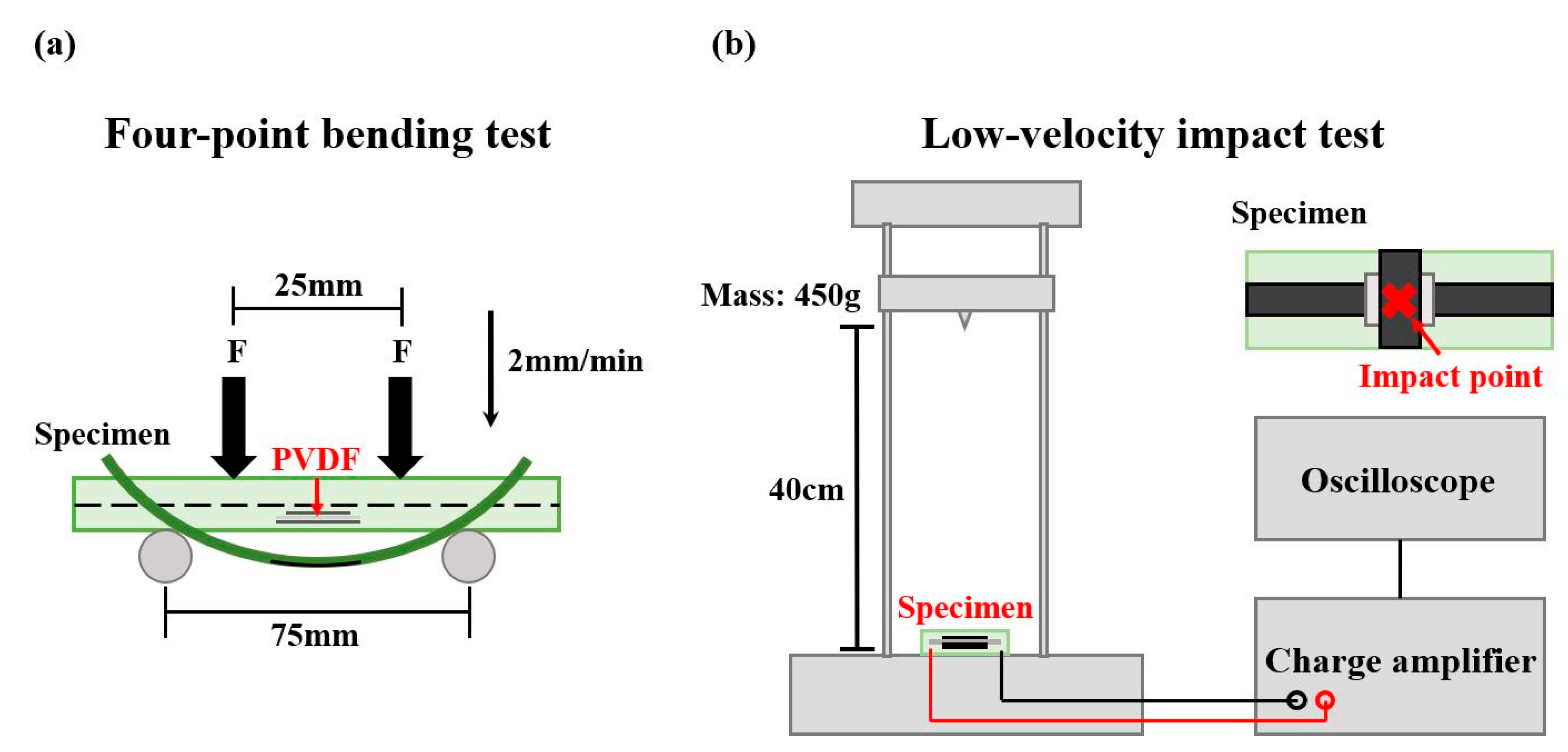
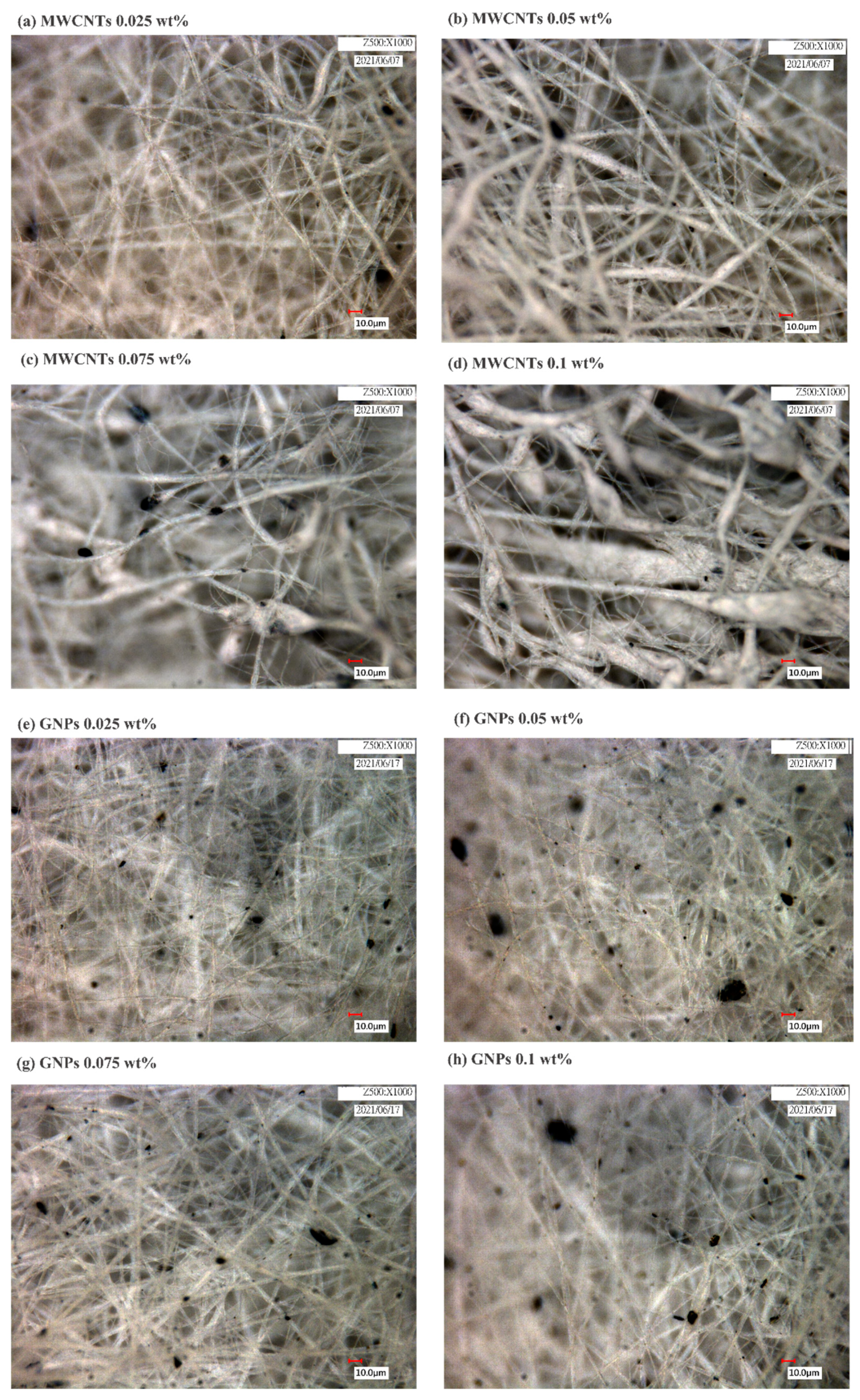
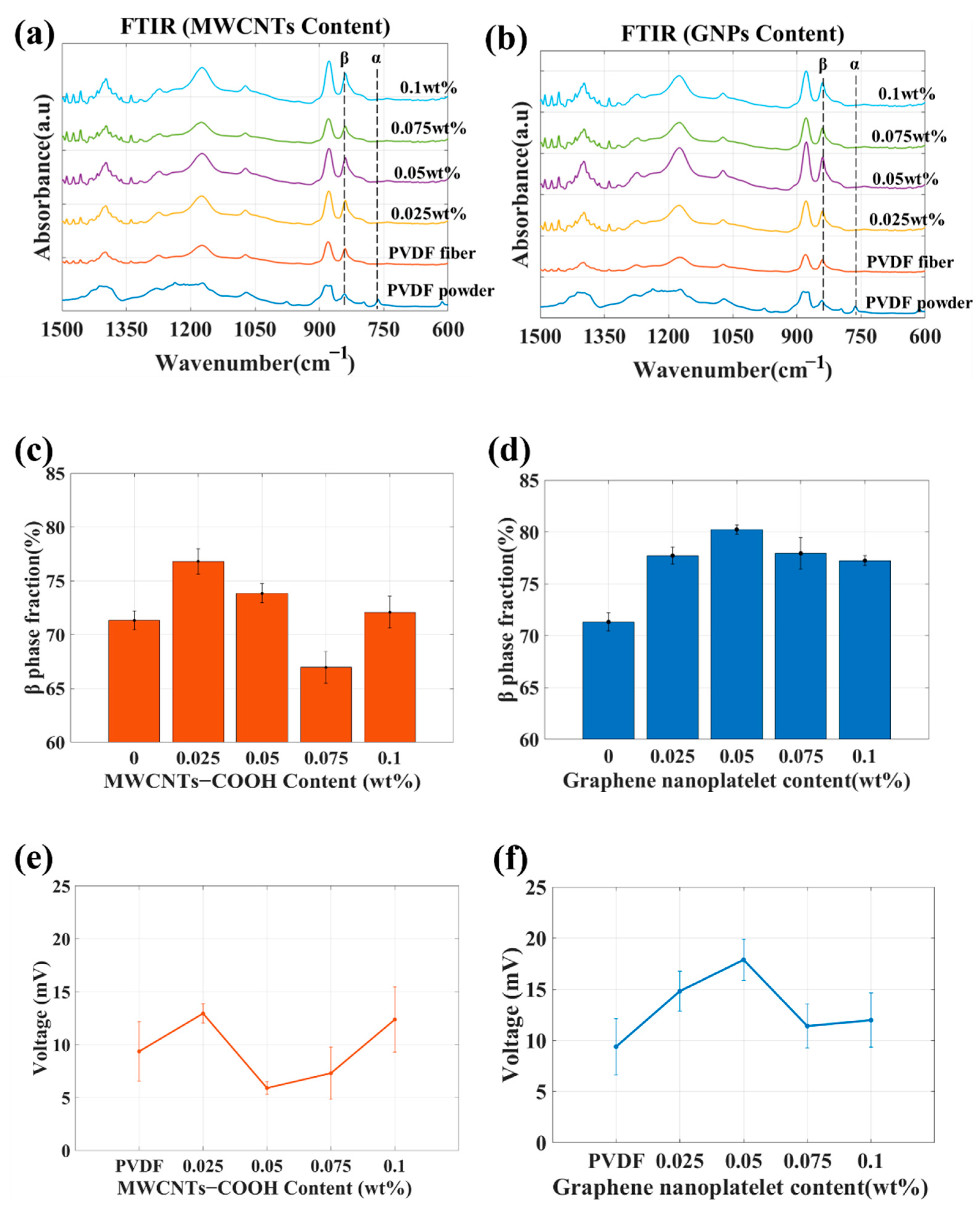
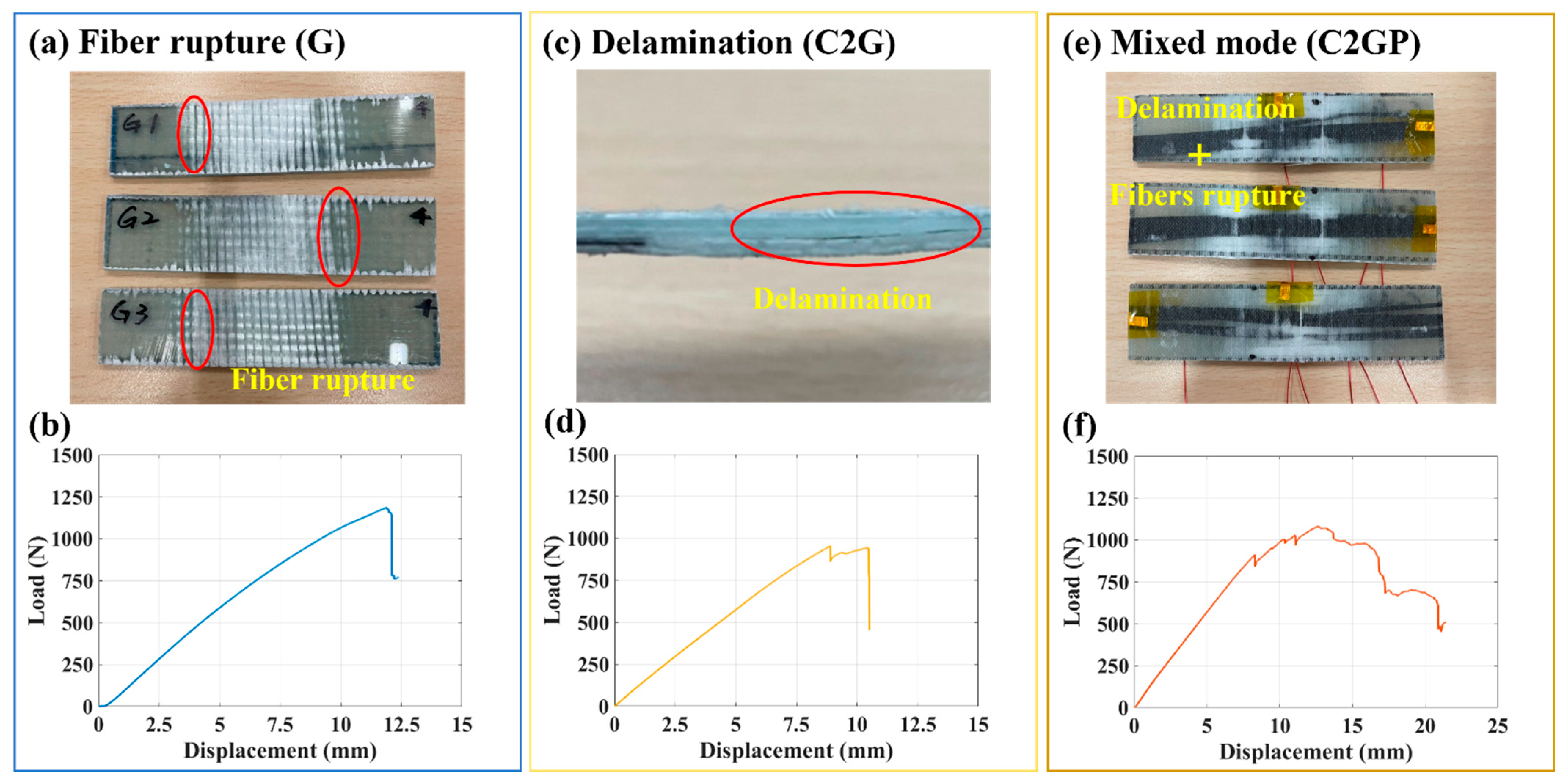

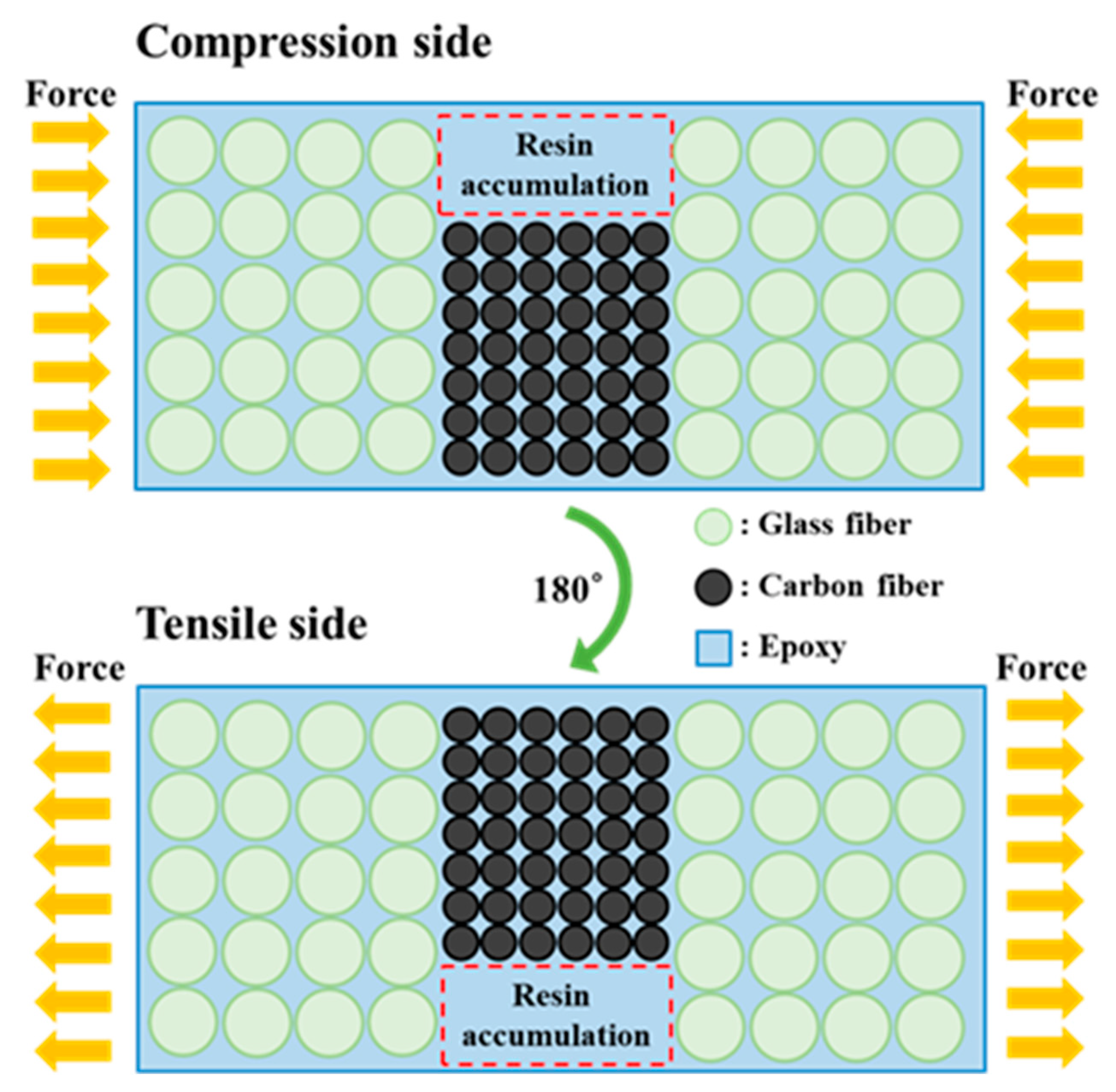
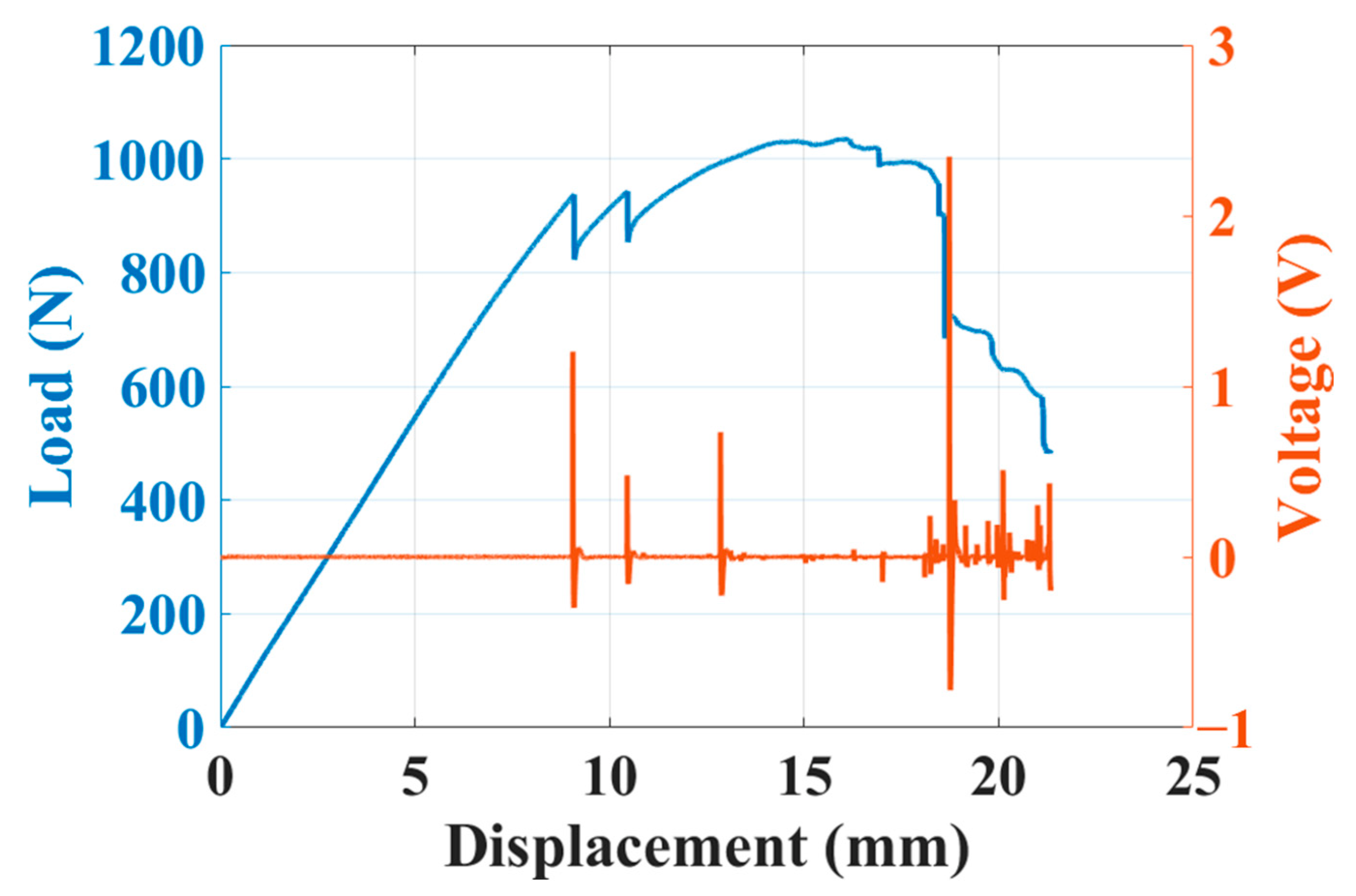
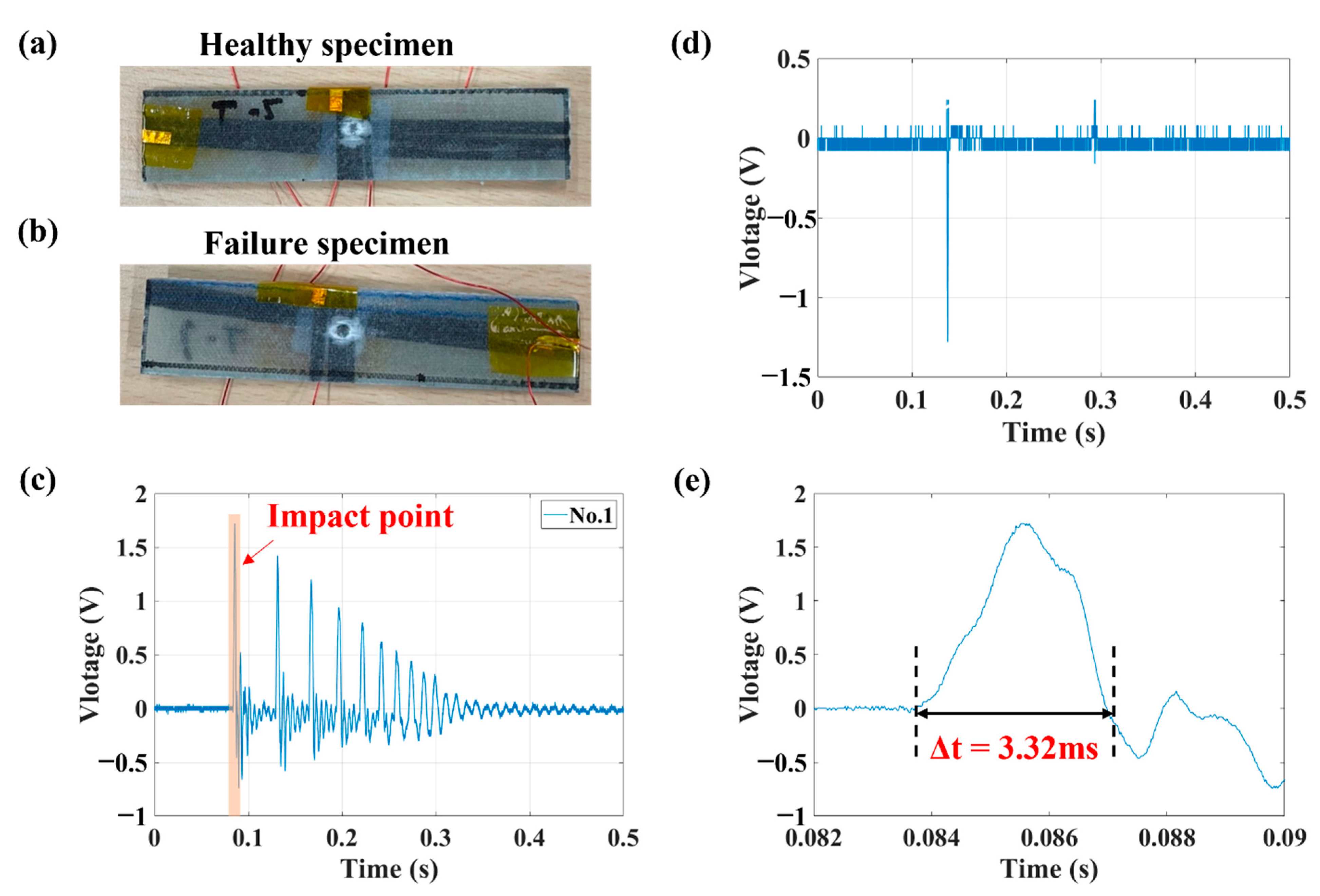

| Specimen | Flexural Strength | Damage Mode | Damage Location |
|---|---|---|---|
| G1 | 709.398 MPa | F, D | C |
| G2 | 866.752 MPa | F, D | C |
| G3 | 774.419 MPa | F, D | C |
| C2G1 | 515.132 MPa | D | T |
| C2G2 | 403.293 MPa | D | T |
| C2G3 | 514.208 MPa | D | T |
| C2GP1 | 1009.445 MPa | F, D | T |
| C2GP2 | 872.840 MPa | F, D | T |
| C2GP3 | 968.182 MPa | F, D | C |
| C2GPC1 | 756.957 MPa | F, D | C |
| C2GPC2 | 614.208 MPa | F, D | C |
| C2GPC3 | 700.495 MPa | F, D | C |
| C2GPT1 | 616.146 MPa | F, D | C |
| C2GPT2 | 584.204 MPa | F, D | T |
| C2GPT3 | 565.659 MPa | F, D | T |
| C4GP1 | 513.814 MPa | F, D | T |
| C4GP2 | 571.842 MPa | F, D | T |
| C4GP3 | 542.341 MPa | F, D | T |
| C6GP1 | 554.551 MPa | F, D | C |
| C6GP2 | 502.585 MPa | F, D | T |
| C6GP3 | 510.966 MPa | F, D | T |
Disclaimer/Publisher’s Note: The statements, opinions and data contained in all publications are solely those of the individual author(s) and contributor(s) and not of MDPI and/or the editor(s). MDPI and/or the editor(s) disclaim responsibility for any injury to people or property resulting from any ideas, methods, instructions or products referred to in the content. |
© 2023 by the authors. Licensee MDPI, Basel, Switzerland. This article is an open access article distributed under the terms and conditions of the Creative Commons Attribution (CC BY) license (https://creativecommons.org/licenses/by/4.0/).
Share and Cite
Cheng, W.-H.; Wu, P.-L.; Huang, H.-H. Electrospun Polyvinylidene Fluoride Piezoelectric Fiber Glass/Carbon Hybrid Self-Sensing Composites for Structural Health Monitoring. Sensors 2023, 23, 3813. https://doi.org/10.3390/s23083813
Cheng W-H, Wu P-L, Huang H-H. Electrospun Polyvinylidene Fluoride Piezoelectric Fiber Glass/Carbon Hybrid Self-Sensing Composites for Structural Health Monitoring. Sensors. 2023; 23(8):3813. https://doi.org/10.3390/s23083813
Chicago/Turabian StyleCheng, Wei-Han, Ping-Lun Wu, and Hsin-Haou Huang. 2023. "Electrospun Polyvinylidene Fluoride Piezoelectric Fiber Glass/Carbon Hybrid Self-Sensing Composites for Structural Health Monitoring" Sensors 23, no. 8: 3813. https://doi.org/10.3390/s23083813
APA StyleCheng, W.-H., Wu, P.-L., & Huang, H.-H. (2023). Electrospun Polyvinylidene Fluoride Piezoelectric Fiber Glass/Carbon Hybrid Self-Sensing Composites for Structural Health Monitoring. Sensors, 23(8), 3813. https://doi.org/10.3390/s23083813









